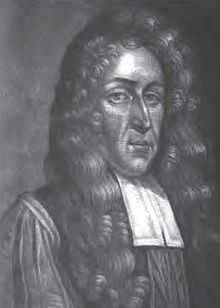Richard Langhorne

Blessed Richard Langhorne (c. 1624 – 14 July 1679) was a barrister executed as part of the Popish Plot.
Background and early life
He was the third son of William Langhorne, a barrister, and Lettice Needham of Little Wymondley in Hertfordshire. He was admitted to the Inner Temple in May 1647 and called to the bar in November 1654. He was a Roman Catholic, and provided legal and financial advice for the Jesuits.[1] During the wave of anti-Catholic hysteria which followed the Great Fire of London, he was briefly arrested but quickly released.
His wife, Dorothy Legatt, was a Protestant from Havering in Essex.[2] His sons Charles and Francis were both priests. When, in October 1677, Titus Oates was expelled from the English College at St Omer "for serious moral lapses", Charles Langhorne entrusted Oates with a letter to his father. Oates returned to St Omer with a letter from Richard thanking the Jesuits for all they had done for his sons.[1]
Arrest
When Oates and Israel Tonge unleashed their Popish Plot in September 1678, three Jesuits and a Benedictine were arrested. Langhorne was arrested a week later, imprisoned at Newgate and charged with Treason. Oates claimed, corroborated by William Bedloe, that Langhorne's earlier correspondence dealt with treason.[1]
Trial and execution
He was tried on 14 June 1679.[3] He was forced to defend himself, as a person charged with treason had no right then to defence counsel. His main defence consisted of an attack on the character of Oates and Bedloe, but since the judges were well aware of the deplorable past lives of both men, this seems to have made little impression.[4] He called a number of students from St Omer to prove that Oates had been at the college on crucial dates when he claimed to be in London, but the public mood was so hostile to Catholics that the witnesses were barely able to make themselves heard, and some were assaulted as they left the Court.[5] Ironically, some of the same witnesses appeared for the prosecution at Oates' own trial for perjury in 1685, where the jury was told to treat their evidence with the greatest seriousness.[6]
William Scroggs, the Lord Chief Justice, although violently prejudiced against Catholic priests, was relatively tolerant of Catholic laymen; his summing up was reasonably fair by the standards of the time, and he did warn the jury that on no account should an innocent man's life be taken away.[7] Nonetheles, Langhorne was found guilty of High Treason.[7]
As the result of a petition by his wife, a ‘true Protestant’, he received a month's reprieve to tidy the affairs of his clients. Kenyon suggests that the Crown was still hoping that he would confess, and it seems that he was offered a royal pardon if he did so. Langhorne was prepared, presumably with the consent of the Jesuit fathers, to give the Crown a list of Jesuit properties in England, but he steadily maintained his innocence.[8] He also wrote a lengthy meditation in verse, which was later published.[8] He was executed at Tyburn, London, on 14 July 1679.[1] Public opinion was slowly turning against the Plot, and Langhorne's courageous death made a favourable impression. [8]
Beatification
On 15 December 1929, he was beatified by Pope Pius XI.[1]
References
| Wikisource has original text related to this article: |
- ↑ 1.0 1.1 1.2 1.3 1.4 McCoog, Thomas M. (January 2008). "Langhorne, Richard (c.1624–1679)". Oxford Dictionary of National Biography. Oxford University Press. doi:10.1093/ref:odnb/16018. Retrieved 2009-10-03. (subscription or UK public library membership required)
- ↑
 "Ven. Richard Langhorne". Catholic Encyclopedia. New York: Robert Appleton Company. 1913.
"Ven. Richard Langhorne". Catholic Encyclopedia. New York: Robert Appleton Company. 1913. - ↑ Kenyon. J.P. The Popish Plot Phoenix Press reissue 2000 p.185
- ↑ Kenyon pp.186-7
- ↑ Kenyon p.187
- ↑ Kenyon pp.285-6
- ↑ 7.0 7.1 Kenyon p.188
- ↑ 8.0 8.1 8.2 Kenyon p.191